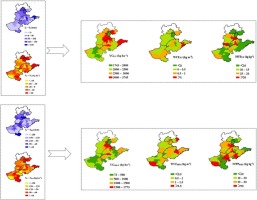当前位置:
X-MOL 学术
›
Agric. Water Manag.
›
论文详情
Our official English website, www.x-mol.net, welcomes your
feedback! (Note: you will need to create a separate account there.)
Does a trade-off between yield and efficiency reduce water and nitrogen inputs of winter wheat in the North China Plain?
Agricultural Water Management ( IF 5.9 ) Pub Date : 2020-04-01 , DOI: 10.1016/j.agwat.2020.106095 Huiqing Bai , Jing Wang , Quanxiao Fang , Binxiang Huang
Agricultural Water Management ( IF 5.9 ) Pub Date : 2020-04-01 , DOI: 10.1016/j.agwat.2020.106095 Huiqing Bai , Jing Wang , Quanxiao Fang , Binxiang Huang

|
Abstract Increasing both grain yield and water use efficiency (WUE)/nitrogen partial factor productivity (NPFP) of winter wheat is crucial to realize the sustainable development of agricultural production in the North China Plain (NCP). This study was conducted to test the hypothesis that a trade-off between yield and efficiency could reduce water and nitrogen inputs of winter wheat in the NCP. Wheat yield, WUE and NPFP under three production levels, i.e. the potential, high-yield and high-efficiency (HH), and on-farm, and their gaps were investigated with APSIM-Wheat model. The results showed that simulated potential yields were close to observed potential yields with RMSE of 1150 kg ha−1 (NRMSE of 12 %) and simulated on-farm yields followed with observed yields with RMSE of 576 kg ha−1 (NRMSE of 8.8 %). Simulated yield gap between the potential and on-farm yields was 2565 kg ha−1 averaged across the NCP from 1981 to 2015 with the highest yield gap in the central part of NCP and the eastern Shandong province, and the corresponding gaps of WUE and NPFP were 0.45 kg m−3 and 10.9 kg N kg−1 with a large spatial difference. To narrow the gaps, about 33 mm additional irrigation and 5 kg N ha−1 reductions from the current irrigation (242 mm) and N fertilizer (267 kg N ha-1) application amounts were needed across the NCP. WUE and NPFP could be increased by 29 % and 43 % from the on-farm to the potential levels. However, if on-farm yield only attained 80 % of the potential, WUE and NPFP could be increased by 0.96 kg m−3 (60 %) and 19.3 kg kg−1 (77 %) across the NCP. Irrigation and nitrogen fertilization amounts could be reduced by averaged 127 mm and 89 kg ha−1 from current averaged irrigation and nitrogen fertilization amounts across the NCP. Especially, the irrigation schedule at on-farm level should be adjusted from three or four irrigations at (sowing), overwintering, jointing and flowering to two irrigations at jointing and flowering across the NCP. Our results suggested an explicit potential for wheat yield and water-nitrogen efficiency win-win by optimizing water and nitrogen management in the NCP.
中文翻译:

产量和效率之间的权衡是否会减少华北平原冬小麦的水氮输入?
摘要 提高冬小麦的粮食产量和水分利用效率(WUE)/氮部分要素生产率(NPFP)是实现华北平原(NCP)农业生产可持续发展的关键。进行这项研究是为了检验产量和效率之间的权衡可以减少 NCP 中冬小麦的水和氮输入的假设。利用APSIM-Wheat模型研究了潜力、高产高效(HH)和田间三个生产水平下小麦产量、WUE和NPFP及其差距。结果表明,模拟的潜在产量接近观察到的潜在产量,RMSE 为 1150 kg ha-1(NRMSE 为 12 %),模拟农场产量紧随其后,RMSE 为 576 kg ha-1(NRMSE 为 8.8 %) )。1981年至2015年NCP的潜在和农场产量之间的模拟产量差距为2565 kg ha-1,其中NCP中部和山东省东部的产量差距最大,WUE和NPFP的相应差距分别为 0.45 kg m-3 和 10.9 kg N kg-1,空间差异较大。为了缩小差距,整个 NCP 需要从当前灌溉(242 毫米)和氮肥(267 公斤 N ha-1)施用量增加约 33 毫米的额外灌溉和 5 千克 N ha-1 减少。从农场到潜在水平,WUE 和 NPFP 可以增加 29% 和 43%。然而,如果农场产量仅达到潜力的 80%,则整个 NCP 的 WUE 和 NPFP 可能增加 0.96 kg m-3 (60%) 和 19.3 kg kg-1 (77%)。与当前整个 NCP 的平均灌溉和施氮量相比,灌溉和施氮量平均可减少 127 mm 和 89 kg ha-1。尤其是农场层面的灌溉计划应从整个NCP的(播种)、越冬、拔节和开花时的三到四次灌溉调整为拔节和开花时的两次灌溉。我们的结果表明,通过优化 NCP 中的水和氮管理,小麦产量和水氮效率双赢具有明显的潜力。
更新日期:2020-04-01
中文翻译:

产量和效率之间的权衡是否会减少华北平原冬小麦的水氮输入?
摘要 提高冬小麦的粮食产量和水分利用效率(WUE)/氮部分要素生产率(NPFP)是实现华北平原(NCP)农业生产可持续发展的关键。进行这项研究是为了检验产量和效率之间的权衡可以减少 NCP 中冬小麦的水和氮输入的假设。利用APSIM-Wheat模型研究了潜力、高产高效(HH)和田间三个生产水平下小麦产量、WUE和NPFP及其差距。结果表明,模拟的潜在产量接近观察到的潜在产量,RMSE 为 1150 kg ha-1(NRMSE 为 12 %),模拟农场产量紧随其后,RMSE 为 576 kg ha-1(NRMSE 为 8.8 %) )。1981年至2015年NCP的潜在和农场产量之间的模拟产量差距为2565 kg ha-1,其中NCP中部和山东省东部的产量差距最大,WUE和NPFP的相应差距分别为 0.45 kg m-3 和 10.9 kg N kg-1,空间差异较大。为了缩小差距,整个 NCP 需要从当前灌溉(242 毫米)和氮肥(267 公斤 N ha-1)施用量增加约 33 毫米的额外灌溉和 5 千克 N ha-1 减少。从农场到潜在水平,WUE 和 NPFP 可以增加 29% 和 43%。然而,如果农场产量仅达到潜力的 80%,则整个 NCP 的 WUE 和 NPFP 可能增加 0.96 kg m-3 (60%) 和 19.3 kg kg-1 (77%)。与当前整个 NCP 的平均灌溉和施氮量相比,灌溉和施氮量平均可减少 127 mm 和 89 kg ha-1。尤其是农场层面的灌溉计划应从整个NCP的(播种)、越冬、拔节和开花时的三到四次灌溉调整为拔节和开花时的两次灌溉。我们的结果表明,通过优化 NCP 中的水和氮管理,小麦产量和水氮效率双赢具有明显的潜力。











































 京公网安备 11010802027423号
京公网安备 11010802027423号